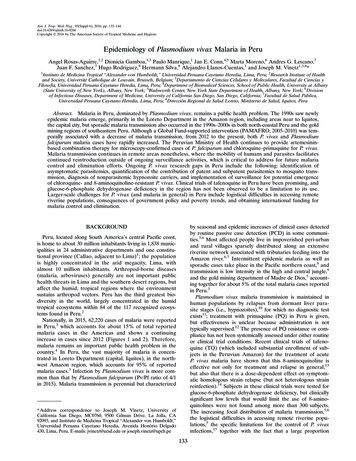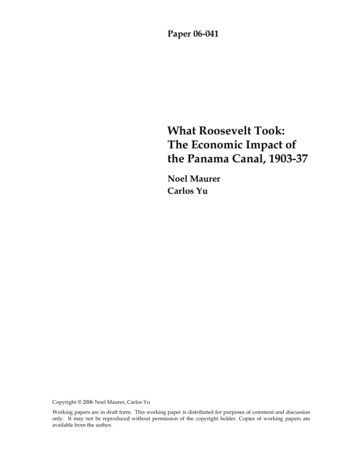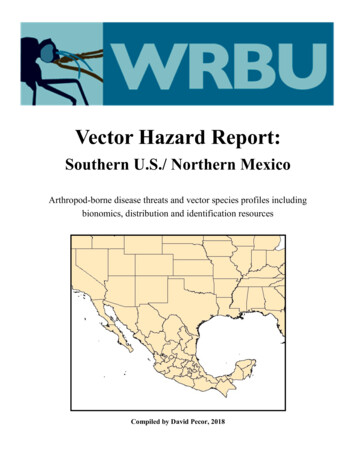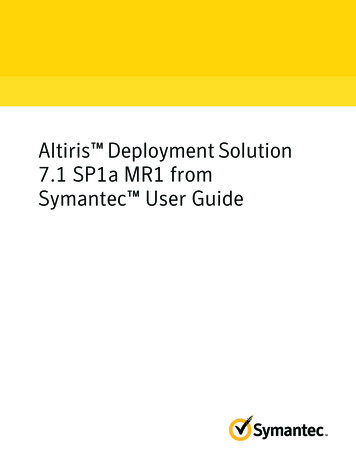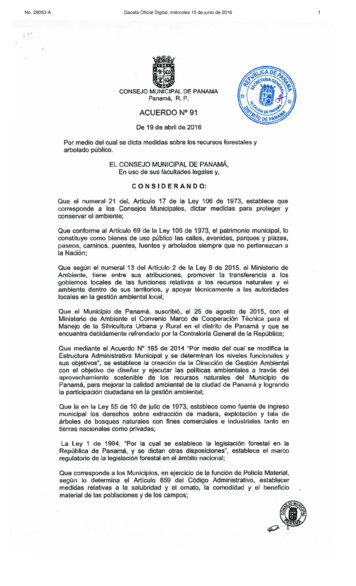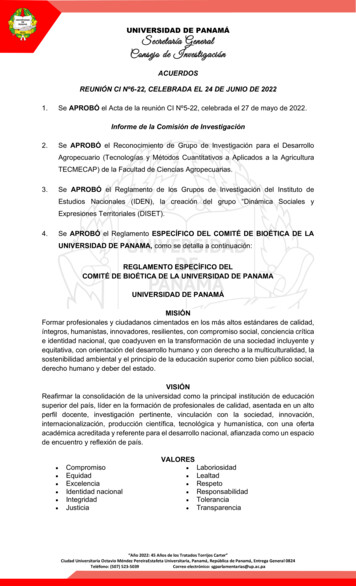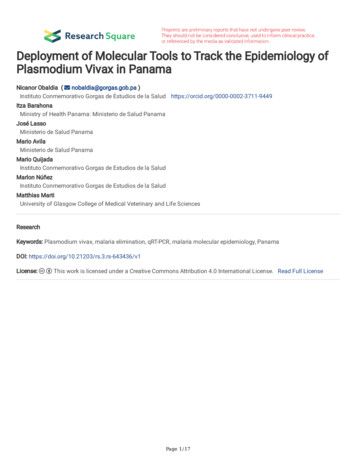
Transcription
Deployment of Molecular Tools to Track the Epidemiology ofPlasmodium Vivax in PanamaNicanor Obaldia ( nobaldia@gorgas.gob.pa )Instituto Conmemorativo Gorgas de Estudios de la Salud https://orcid.org/0000-0002-3711-9449Itza BarahonaMinistry of Health Panama: Ministerio de Salud PanamaJosé LassoMinisterio de Salud PanamaMario AvilaMinisterio de Salud PanamaMario QuijadaInstituto Conmemorativo Gorgas de Estudios de la SaludMarlon NúñezInstituto Conmemorativo Gorgas de Estudios de la SaludMatthias MartiUniversity of Glasgow College of Medical Veterinary and Life SciencesResearchKeywords: Plasmodium vivax, malaria elimination, qRT-PCR, malaria molecular epidemiology, PanamaDOI: https://doi.org/10.21203/rs.3.rs-643436/v1License: This work is licensed under a Creative Commons Attribution 4.0 International License. Read Full LicensePage 1/17
AbstractBackground: As the elimination of malaria in Mesoamerica progresses, detection of Plasmodium vivax asymptomaticpatients using conventional diagnostic methods becomes more difficult. Highly sensitive molecular methods are key for thedetermination of the hidden reservoir of malaria transmission on the road to elimination in countries in the pre-eliminationphase such as Panama. Here we describe the clinical validation of a qRT-PCR assay for the detection of P. vivax asexual andsexual stages from low blood volume field samples preserved at ambient temperature.Methods: We collected blood samples from a cross sectional cohort of P. vivax patients in Panama. Different storage formats(room temperature, frozen) and blood volumes were compared to establish the sensitivity of parasite detection includingtransmission stages (gametocytes) by qRT-PCR and diagnostic microscopy.Results: Study results indicated that blood storage at room temperature using an RNA preservation solution for up to 8 dayswas sufficient to preserve RNA for subsequent qRT-PCR assays. Detection of gametocytes by qRT-PCR was more sensitivethan light microscopy using both our recently established marker PvLAP5 and the gold standard Pvs25, confirming that bothmarkers are suitable for P. vivax gametocyte detection in the field using the above protocol.Conclusions: This study validates a low blood volume qRT-PCR assay system for the detection of P. vivax asexual and sexualstages in field samples preserved at ambient temperature. Results indicate that the assay system is a reliable tool todetermine the transmission reservoir of P. vivax in remote areas such as endemic regions of Panama.BackgroundEach year an estimated 229 million cases and 409,000 deaths attributable to malaria mainly in children under 5 years arereported globally, 85% of which occur in Sub-Saharan Africa (1). In other parts of the world malaria deaths occur mainly innon-immune individuals of all ages. The majority of malaria cases and deaths are due to Plasmodium falciparum, however inmany regions outside of sub-Saharan Africa P. vivax predominates (1). P. vivax remains a major cause of morbidity andmortality in Southeast Asia, India, the Western Pacific and the Americas, and it remains present across sub-Saharan Africa (2).In the Americas, malaria continues to be a major problem in poorly developed areas and indigenous communities such as partof the Amazon region, while it is under control in urban settings (3, 4).Global efforts to eradicate malaria have been stimulated by a dramatic drop in the incidence of the disease in sub-SaharanAfrica (5–7). For instance, between 2000 and 2015 the incidence of malaria has declined by approximately 37 % and thedeath rate by 60% worldwide (8). Similarly, the global burden of P. vivax malaria decreased by 41.6% between 2000 and 2017,and in the Americas by 56.8% since 2000 (9). Unfortunately, parasite resistance to the major anti-malarial drugs includingArtemisinin is rapidly spreading and threatening ongoing elimination strategies (10–12).Major gaps in the understanding of P. vivax transmission and the human reservoir remain to be elucidated. Many expertsagree that as P. falciparum is eliminated, P. vivax will remain endemic due to existence of latent liver stages (hypnozoites) thatcan cause relapses even years after infection. In addition, little is known about its population structure in many endemicregions and the extent of asymptomatic carriers (13, 14). On the other hand, there is currently no system of continuous in vitroculture that would accelerate basic research and development of new drugs, vaccines and diagnostic tests (15, 16). Recentstudies have reported high rates of sub-microscopic P. vivax infections in areas of low transmission such as the SolomonIslands (17). Similar conditions are found in endemic areas of Panama, where its inhabitants live in low transmission settingsmostly associated with Amerindian reservations (4). Such settings contain multiple foci or pockets (“Hot Spots”) oftransmission, which can present logistical and technical challenges for malaria control programs due to remoteness andlimited sensitivity of available diagnostic tests (i.e., thick blood smears and rapid diagnostic tests (RDTs))(18)(19).Gametocytes of P. vivax appear early in infection, between 3–5 days after the first asexual parasites are detected incirculation, and before the patient is symptomatic (20). Hence, P. vivax can be transmitted to mosquitoes before the onset ofPage 2/17
symptoms (21, 22). The reason for the early transmissibility is the relatively short gametocyte development of approximately48 hours (14) compared to 10–12 days in P. falciparum. As in P. falciparum, developing (immature) P. vivax gametocytes arepredominantly found in the hematopoietic niche of the bone marrow (and possibly spleen)(14, 23, 24). The detection ofmature P. vivax and P. falciparum gametocytes in blood samples by light microscopy is imprecise due to their low levels incirculation (25). Molecular diagnostic tools that detect asymptomatic P. vivax carriers with sub patent infections have beendeveloped (18, 26). These assays use the P. vivax 18s ribosomal RNA gene (Pv18SrRNA) or the mature gametocyte markerPvs25 (25, 27). Notably, both markers can amplify from genomic DNA (gDNA). Other P. vivax gametocyte markers such asPvs28, Pv41, Pvs48 /45, and Pvs230 have been described and characterized (28–32), but none of these genes has beenvalidated as a gametocyte detection tool in field samples. We recently characterized PvLAP5 as a P. vivax mature gametocytemarker by qRT-PCR assay and using a specific antiserum (14, 33).Here we present establishment and validation of a field deployable diagnostic test for detection of P. vivax asexual andgametocyte stages, using finger prick blood, storage and transport at ambient temperature and qRT-PCR amplification ofPv18s rRNA, Pvs25 and PvLAP5 markers.We expect that this assay will contribute to the detection of the asymptomatic P. vivax reservoir, and hence accelerate theelimination of persistent P. vivax malaria transmission from endemic foci in low transmission settings such as Panama.MethodsStudy Design. The aim of the study was to validate a qRT-PCR assay for the detection of P. vivax asexual and sexual stagesusing small blood volume and no cold chain. Clinical samples were collected during 2017–2019 from Pv malaria positive andnegative individuals detected by passive or active surveillance by technicians from the National Vector Control Department ofthe Ministry of Health (MINSA) of Panama.Ethics. Study protocol and consent form approval was obtained from The Gorgas Memorial Institutional Bioethics ReviewCommittee (No. 276/CBI/ICGES/16). Written informed consent was obtained from the participants. Animal blood samplesused in this study were obtained from the ICGES malaria strains repository, or from animals inoculated for use as donors inother protocols. Collection of malaria naïve Aotus monkey blood was carried out as part of a routine animal health program.All animals were maintained and treated in accordance with the Guide for the Use for the Care and Use of Laboratory Animals,eighth edition 2011, National Research Council, Washington, DC.Epidemiology of Plasmodium vivax in Panama during 2017–2020. P. vivax malaria incidence maps at the level ofcorregimiento (smallest political division) for the years 2017–2020 were prepared with data obtained from the National VectorControl Program of the Ministry of Health of Panama using ArcMap 10.6.1. software (Esri, Redlands, CA). Epidemiologicalcurves by year, month and age groups for the years 2017–2020, as well as the ethnicity distribution of study participants forthe years 2017–2019 were prepared using the Prism 6.0 (GraphPad Software, Inc, La Jolla, CA, USA) and Excel (Microsoft,Seattle, WA) software.Spatial, demographic, and socioeconomic characteristics of the study population. Spatial, demographic, and socioeconomicinformation was gathered from each study participant using an epidemiological survey form developed with the Survey123for ArcGIS online survey software (Esri, Redlands, CA).Blood sampling. Thin and thick blood smears were prepared from a finger-prick made with a lancet. Blood smears were thendried and transported to the laboratory for staining with Giemsa, parasite density determination, species identification andstage differential counts. Additionally, 60–120 µL of finger prick blood were collected into 1.8 ml NUNC cryovials containing500 µL of RNAprotect (RNAp) (Qiagen, Germany) for RNA isolation and qRT-PCR assay. Samples were transported to thelaboratory at ambient temperature and the cryovials stored at -80 Celsius at arrival. In total, 150 µL of blood were obtainedfrom each volunteer including blood smears.Page 3/17
Microscopy. Giemsa stained thick and thin blood smears were examined by light microscopy for parasitemia densitydetermination, Plasmodium species confirmation and stage differential counts. Parasite densities were calculated byquantifying the number of malaria infected red blood cells (iRBCs) among 500–2000 RBCs on a thin blood smear andexpressing the results as % parasitemia (% parasitemia parasitized RBCs /total RBCs) x 100), or quantifying parasitesagainst white blood cells (WBCs) on the thick smear until 500 or 1000 WBCs were counted (parasitized RBCs x µL of blood,assuming 8,000 WBC/µL of blood). Stage differential counts were expressed as percentage of total parasite stages counted.qRT-PCR assayParasites. P. vivax SAL-1 Aotus infected whole blood from experimentally inoculated and malaria naive Aotus, kept at theGorgas Memorial Institute in Panama, were used as positive and negative controls for the qRT-PCR assay as described (33).Heparin anticoagulated whole blood from fifteen male and female Aotus monkeys was used as negative controls todetermine the cut-off point Cycle Threshold (Ct) value of the qRT-PCR assay. P. vivax SAL-1 infected anticoagulated (SodiumCitrate 4% Solution, Sigma, St. Louis, MO) whole blood obtained from a donor Aotus animal MN12939 was used as positivecontrol.Primers. We used forward and reverse primers sets for PvLAP5 and Pvs25 and Pv18SrRNA as previously described (33)(Supplementary Table S1). PvLAP5 primers were designed to span exon-exon junctions to minimize amplification from gDNA.As gold standard control, we used primers for the gametocyte marker Pvs25. Primer sets including PvLAP5, Pvs25 andPv18SrRNA were synthesized by Genscript (Piscataway, NJ, USA).RNA extraction and cDNA synthesis. RNA was isolated from RNAp preserved blood samples with the Qiagen RNAeasy Pluskit including a gDNA eliminator column (Qiagen, Germany) per the manufacturer’s instructions. RNA concentration wasmeasured in a NanoDrop ND spectrophotometer (Thermo Fisher Scientific Inc, USA) and the nucleic acid treated with DNAfree kit (Ambion, Life Technologies, USA) for removal of residual DNA. The treated RNA was then transcribed to cDNA withthe QuantiTect Reverse Transcription Kit (Qiagen, Germany) following the manufacturer’s instructions.Procedure for the qRT-PCR assay. Assay reactions were performed in a QuantStudio 5 Real-Time PCR 384 well plate system(Applied Biosystems ) as described (14). Each Fast SYBR Green reaction (final volume of 20 µL) consisted of Master MixFast SYBR Green (Applied Biosystems ) forward and reverse primers mix at 300 nm concentration and 2 µL of cDNA.Thermal cycle conditions were as follows: 10 min at 95 C, followed by 40 cycles at 95 C for 15 s, 60 C for 1 min. A meltingcurve analysis was added at the end of the reaction cycle. Samples were analysed in duplicate. Each plate included a positiveand negative control (uninfected sample) and a negative amplification control. A Ct value of 38 for the endogenousPv18SrRNA gene marker was used as the positive threshold for P. vivax detection. The Ct cut-off point of 38 was calculatedfrom the mean Ct value of sixteen malaria smear negative human and fifteen Aotus monkey controls minus two standarddeviations as shown on Supplementary Tables S2 and S3.Field validation of the qRT-PCR assayqRT-PCR assay of field samples. To validate the qRT-PCR assay and sample preservation system in the field, we determinedthe mean negative Ct value threshold using 16 smear negative samples for each marker. The negative Ct value threshold wasdefined as the mean Ct value – 2 standard deviations from the mean. We subsequently tested 45 smear positive P. vivaxsamples for PvLAP5, Pvs25 and Pv18SrRNA as described (14). Representative qRT-PCR assay amplification and melt curveplots of a positive P. vivax sample is shown in Supplementary Figure S1.Assay validation. Using the open web based tool “Diagnostic Test Evaluation tic test.php) (MedCalc Software Ltd, Osten, Belgium) we determined the followingparameters: i) the sensitivity (Se, probability that a test result will be positive when the disease is present (true positive rate));ii) the specificity (Sp, probability that a test result will be negative when the disease is not present (true negative rate)); iii) thepositive likelihood ratio (PLR, ratio between the probability of a positive test result given the presence of the disease and theprobability of a positive test result given the absence of the disease (True positive rate / False positive rate Sensitivity / (1Page 4/17
Specificity)); iv) the negative likelihood ratio (NLR, ratio between the probability of a negative test result given the presence ofthe disease and the probability of a negative test result given the absence of the disease (False negative rate / True negativerate (1-Sensitivity) / Specificity)); v) the positive predictive value (PPV, probability that the disease is present when the test ispositive); and vi) the negative predictive value (NPV, probability that the disease is not present when the test is negative).These two last definitions depend on the disease prevalence (34, 35).The data was then tabulated on a series of 2 x 2 tables as follows: a) the number of P. vivax microscopic field positive slides(disease present), b) negative control smears (disease absent), c) the number of qRT-PCR positive samples (test positive) andd) number of negative control samples (test negative) for each gametocyte gene marker (PvLAP5 and Pvs25) and theendogenous marker Pv18SrRNA as described (36–38). For validation we calculated the theoretical minimum number ofpositive and negative samples necessary to achieve a level of sensitivity of 97% and specificity of 99% with a margin of errorof 2–5% and a confidence level of 95% as described (37).Statistics. Statistical analysis was done using the statistical and graphics software Prism 6.0 (GraphPad Software, Inc, LaJolla, CA, USA), the JMP Pro Statistical software (SAS Institute Inc., Cary, NC, USA) and the Web based Diagnostic TestEvaluation Calculator (https://www.medcalc.org/calc/diagnostic test.php) (MedCalc Software Ltd, Osten, Belgium).ResultsThe overall goal of this study was to validate a qRT-PCR assay for the detection of P. vivax using clinical samples fromPanama. Specifically, we aimed to i) compare the microscopic parasite detection rate (gold standard) to detection by qRT-PCRassay using mature gametocyte markers Pvs25 and PvLAP5 and constitutive marker Pv18SrRNA, and ii) validate the assayprotocol for ongoing elimination efforts in Panama and Mesoamerica.Epidemiology of Plasmodium vivax in Panama during 2017–2020During the period between 2017–2020 the highest P. vivax incidence occurred in individuals living in the indigenous comarcasand the provinces of Panama and Darien (Fig. 1a), with most of the cases ( 70%) reported occurring in subjects less than 29years old (Fig. 1b) and of Amerindian ethnicity (Fig. 1c). The epidemiological curve for the year of 2017 shows cases peakingin February during the middle of the dry season ( 90 cases) and again in December at the beginning of the next dry season ( 75 cases). A similar pattern can be observed in 2018. In contrast, during 2019 the number of cases increased to 1646 (plus43% compared to 2018) with a peak of more than 300 cases reported during dry season in February/March and a similartrend in 2020, suggesting the occurrence of an epidemic outbreak during these two years (Fig. 1d).Demographic characteristics of the study populationStudy participants comprised of volunteers that were residents of the provinces of Darien, Panama, Veraguas and theIndigenous Comarca of Guna Yala (Fig. 2a). In total 73 participants were enrolled in the study: 45 subjects with P. vivax basedon Giemsa smear positivity, 8 with P. falciparum and 16 malaria smear negative controls. Four subjects were later excludedfrom the study due to insufficient blood sample volume. 64 % of the participants were male and 36 % female, with a medianage of 24 for male (range: 0.5 to 76) and 21 for female (range: 0.5, 53) years. Most participants (42%) were Amerindians andall combined, 93% were residents of the provinces of Darien (26 %), Panama (40 %), and the Comarca Guna Yala (27 %).Including all age groups, 26 % of the participants were unemployed at the time of the survey, 14 % illiterate, and 44 % lived intype 2 and 3 houses as defined previously (4), with 6 (range: 1, 18) dwellers on average per household (Supplementary TablesS4 and S5).Parasite characteristics by light microscopyTo determine the proportion of asexual and sexual stages in the field samples, we examined Giemsa thin blood smears fromeach study participant. Representative images of P. vivax asexual stages, including rings, trophozoites, schizonts andgametocytes are shown in Fig. 2b. All stages were detected at similar prevalence (rings: 76%, trophozoites: 88%, schizonts:Page 5/17
76%) except for the less abundant gametocytes (62%). As previously reported schizont and gametocyte stages are present atsignificantly lower levels in the peripheral blood than rings and trophozoites, presumably due to their tissue enrichment (14)(Figs. 2c,d).Sample processing and molecular detection of P. vivax by qRT-PCRTo optimize the blood volume and processing of field samples for parasite stage analysis by qRT-PCR, we designed anexperiment simulating field conditions prior to the start of this study. For this purpose, we amplified the reference strain P.vivax SAL-1 in the Aotus non-human primate model. Fifteen days after infection, when parasitemia reached 51,080 parasites xµL, blood was collected. A total volume of 60 or 120 µL of P. vivax-infected blood, respectively, was preserved in RNAp foreight days at ambient temperature ( 27 degrees Celsius), or frozen immediately at -80 degrees Celsius. Samples acrossconditions were then processed for RNA isolation and subsequent cDNA synthesis and qRT-PCR. Comparison using ANOVArevealed no statistically significant differences across conditions using the 3 markers (Pvx18s rRNA, Pvs25, PvLAP5) (Table1). For this field study, we therefore decided to collect 60 µL of sample and store in RNAp media at room temperature for up to8 days before processing.Molecular assays were performed on thesubset of 45 P. vivax smear positive field cases (Supplementary Table S6). The assaydetection rate for all P. vivax parasites using Pv18SrRNA was 44/45 (98 %), and for sexual stages 41/45 (91 %) for both Pvs25and PvLAP5 (Fig.3a). In contrast, microscopic examination only detected gametocytes in 26/42 (62 %) of available smears.This represents a 47 % increase in the detection rate of gametocytes by qRT-PCR assays over microscopy. Comparison ofrelative transcript expression for PvLAP5vsPvs25 revealed significantly higher relative expression of PvLAP5 (Fig.3b,c). Theanalytical sensitivity of the qRT-PCR assays had been established previously (14). In this study the clinical limit of detection(LOD) of the qRT-PCR assay was established by limiting dilution of clinical samples where we had determined parasite stageconcentration (see Fig.2d). PvLAP5 was detected at a minimum concentration of 1.44 gametocytes x µL and Pvs25 at 0.144gametocytes x µL (Fig.3d). Hence, the PvLAP5 and Pvs25qRT-PCR assays are estimated to be 5–50 fold more sensitive thanthe theoretical qRT-PCR LOD that was previously established at 9.6 gametocytes x µL (39).To further compare the detection rate of the qRT-PCR assays to the gold standard of gametocyte detection (microscopy), weanalysed the association of study variables age, sample days in transit to the laboratory, whole RNA concentration, mean %parasitemia and marker Ct values with microscopy detection of gametocytes (gametocyte positive 1 and negative 0). Astatistically significant association between categories was detected for mean parasitemia % (p 0.03) and all qRT-PCRmarkers (PvLAP5: p 0.02, Pvs25: p 0.007; Pv18SrRNA: p 0.02), but not for any other variable (Table 2 and Fig. 3e).Multivariate analysis demonstrated strong positive correlation between gametocyte markers PvLAP5 and Pvs25 (r 0.8507; p 0.001) and between Pv18SrRNA and PvLAP5 (r 0.5034; p 0.001) and Pvs25 (r 0.8891; p 0.001) (Table 3). To assessthe validity of the qRT-PCR assays at detecting P. vivax in field samples preserved in RNAp at ambient temperature, wedetermined sensitivity (Se), specificity (Sp) as well as positive and negative likelihood ratios (PLR, NLR) and predictive values(PPV, NPV) using microscopy as the gold standard. Indeed, all qRT-PCR assays have high Se and Sp (80% or greater), withPvLAP5 having slightly higher probability of detecting a true positive gametocyte sample compared to Pvs25 (Table 4and supplementary Tables S7-9).DiscussionAs malaria continues to decline (10), elimination from endemic foci where residual transmission persists is a constantchallenge for countries on the verge of elimination by WHO standards (8). To closely monitor advances towards elimination, itis important to maintain a robust malaria molecular epidemiological surveillance program, especially in remote areas thatlack the infrastructure to maintain a cold chain. Previous genomic studies have found extremely high clonality in thePanamanian P. vivax population, with clonal lineage 1 (CL1) persisting for at least the past 10 years and CL2 circulatingmainly in the Darien province (19). In this study, we deployed and field validated molecular tools for detection of P. vivax usingfield samples preserved and transported at ambient temperature from remote areas of Panama.Page 6/17
We observed an increase in malaria cases during the period 2019–2020 with respect to the previous two years, suggesting anepidemic outbreak during the dry season. Reasons for this outbreak are currently unclear but extreme weather conditions(Tropical storms and hurricanes that impacted Central America and the Caribbean during the 2019–2020) (40), or prolongedconfinement for the control of the COVID-19 pandemic might have contributed to it.Hurricanes (41) and other extreme weather events such as the “El Niño Southern Oscillation (ENSO)”, which was particularlystrong during 2018–2019 in the region (42), have been associated with changes in malaria transmission in Panama and theCaribbean (43, 44). However, we cannot rule out other factors such as increased detection to the introduction of Malaria RDTsin 2017 by MINSA (1) (see supplementary Table S10), changes in vectorial transmission efficiency (45, 46), reintroduction ofparasites (19, 33), waning immunity due to lack of exposure (47) and socioeconomic factors that affect these communities(4).P. vivax qRT-PCR assays based on detection of ribosomal RNA from low blood volume field samples stored without cold chainhave previously been validated for molecular epidemiological studies (18). The method takes advantage of abundant18SrRNA transcripts present in blood stage parasites circulating in peripheral blood. Similar approaches for P. vivaxgametocytes detection by qRT-PCR using Pvs25 has been described elsewhere (25, 48). P. vivax gametocytes represent asmall fraction of the total parasite mass found in an infected individual, especially in asymptomatic patients with generallylow parasite load. Therefore, detection by conventional microscopy has limited application for P. vivax gametocytes. We havepreviously demonstrated that PvLAP5 detects P. vivax gametocytes in infected non-human primates, both using specificantibodies and by qRT-PCR. Here, we deployed a qRT-PCR assay for the detection of PvLAP5, the gametocyte gold standardPvs25 and Pv18s rRNA using low blood volume and sample storage at ambient temperature. Unlike Pvs25, PvLAP5 qRT-PCRdetection uses exon-spanning primers thereby minimising spurious amplification from DNA. We validated the usefulness ofthe assay as a molecular epidemiological tool for the determination of the hidden transmission reservoir in individuals livingin remote areas of Panama (14). Results of our study indicate that 60 µL of blood obtained by finger prick and preserved inRNAp at ambient temperature provided similar qRT-PCR results compared to controls stored at -80 degrees Celsius.Both PvLAP5 and Pvs25 qRT-PCR assays showed at least 57% improvement for detection of gametocytes over lightmicroscopy in field samples. Markers show similarly high sensitivity and specificity, confirming their suitability as gametocytemarkers for molecular epidemiological surveys (38). Our assay system can be used as a screening tool to determine the P.vivax transmission reservoir in asymptomatic carriers and low transmission settings and to maintain a robust molecularepidemiological surveillance program in remote areas.DeclarationsAuthor contributionsN.O.III. Experimental design and conceptualization, resources, funding acquisition, methodology, fieldwork, performedexperiments, analysed data and wrote the manuscript. M.Q. and M.N. performed experiments and qRT-PCR assays. M.N., I.B.,J.L., and M.A., participated in the planning and execution of field sampling. M.M. Planning of molecular assays, field site visit,analysed data and wrote the manuscript with N.O.III. Field sampling was carried out by technicians from the National VectorControl Program of the Ministry of Health of Panama, Republic of Panama.Page 7/17
ConceptualizationNicanor Obaldia III, Matthias MartiData CurationNicanor Obaldia IIIFormal AnalysisNicanor Obaldia III, Matthias MartiFunding AcquisitionNicanor Obaldia III, Matthias MartiInvestigationNicanor Obaldia III, Marlon Núñez, Mario Quijada, Mario AvilaProject AdministrationNicanor Obaldia IIIResourcesNicanor Obaldia III, Itzá Barahona, José Lasso, Mario ÁvilaValidationNicanor Obaldia IIIVisualizationNicanor Obaldia III, Matthias MartiWriting – Original Draft PreparationNicanor Obaldia IIIWriting – Review & EditingNicanor Obaldia III, Matthias MartiCompeting InterestsThe authors declare no conflict of interest related to the publication of this manuscript.Grant InformationThis study was supported in part by grant contracts: SENACYT grant ITE15-004, Instituto Conmemorativo Gorgas de Estudiosde la Salud, the Harvard TH Chan School of Public Health, Boston, MA. USA, the Ministry of Health of Panama, Republic ofPanama and the Sistema Nacional de Investigación (SNI) of Panamá. M.M. is supported by a Royal Society Wolfson Meritaward and Wellcome Center award 104111.AcknowledgmentsThe authors thanks at ICGES, Néstor Sosa, Azael Saldaña and Gladys Tuñón, for their administrative support; also, indebted atICGES to Ariel Magallón, and José C. Marín (R.I.P.) for their support in the implementation of a field sample collection trainingworkshops. We are also grateful to Iriela Aguilar, Paola Rivera and Milagros Mainieri at the Department of Research andDevelopment (I D), Secretary of Science, Technology and Innovation (SENACYT) of the Government of the Republic ofPanamá, for their administrative and technical support with project management. We dedicate this manuscript to our coauthor José Lasso, who sadly passed away during the drafting of the manuscript.Availability of Data and MaterialsAll data generated or analysed during this study are included in this published article [and its supplementary information files].References1. WHO. 2020. World Malaria Report. WHO.2. Howes RE, Reiner RC, Jr., Battle KE, Longbottom J, Mappin B, Ordanovich D, Tatem AJ, Drakeley C, Gething PW,Zimmerman PA, Smith DL, Hay SI. 2015. Plasmodium vivax Transmission in Africa. PLoS Negl Trop Dis 9:e0004222.3. Arevalo-Herrera M, Quinones ML, Guerra C, Cespedes N, Giron S, Ahumada M, Pineros JG, Padilla N, Terrientes Z, Rosas A,Padilla JC, Escalante AA, Beier JC, Herrera S. 2012. Malaria in selected non-Amazonian countries of Latin America. ActaTrop 121:303-314.4. Obaldia N, 3rd. 2015. Determinants of low socio-economic status and risk of Plasmodium vivax malaria infection inPanama (2009-2012): a case-control study. Malar J 14:14.Page 8/17
5. Bassat Q, Alonso PL. 2011. Defying malaria: Fathoming severe Plasmodium vivax disease. Nat Med 17:48-49.6. The malERA CGoM. 2011. A research agenda for malaria eradica
the QuantiTect Reverse Transcription Kit (Qiagen, Germany) following the manufacturer's instructions. Procedure for the qRT-PCR assay. Assay reactions were performed in a QuantStudio 5 Real-Time PCR 384 well plate system (Applied Biosystems ) as described (14). Each Fast SYBR Green reaction (nal volume of 20 µL) consisted of Master Mix
